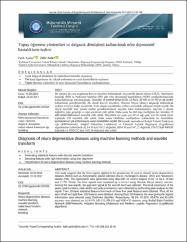Diagnosis of neuro degenerative diseases using machine learning methods and wavelet transform
Abstract
This study suggests that the force signals applied to the ground may be used to classify neuro-degenerative diseases (NDD) such as Amyotrophic lateral sclerosis (ALS), Huntington's disease (HD) and Parkinson's disease (PD). The experiments were performed using data with 16 control subjects (CO), 13 ALS, 20 HD and 15 PD. Firstly, the force signals were separated up to level-7 using Discrete Meyer (dmey) wavelet. Among the new signals, the approach signal at the seventh level was selected. The local maximums of the peaks, peak locations, peak widths and peak prominences were obtained by performing peak analysis on this signal. Then, 15 basic statistical features from each of these four peak features were obtained. Thus, 60 for each of left and right foot, 120 features were obtained. Among these 120 features, the ones giving the highest information were selected using OneRules classifier. Respectively, 93.1%, 97.22%, 83.87% and 92.18% accuracy was obtained on ALS-CO, HD-CO, PD-CO and NDD-CO datasets using Radial Basis Function Network (RBFNetwork), Adaptive Boosting (Adaboost) and Additive Logistic Regression (LogitBoost) algorithms.



















